Last week – we told you about the Chiquibul Symposium – a meeting of the minds to figure out how to solve the problem that faces this vast national park. The problem is, simply, that Guatemalan farmers in search of fertile land are pushing over from the Peten to make their farms in the Chiquibul. Last week at the symposium, the BDF Commander called it "alarming." But to hear it said is one thing, to see it, quote another. So yesterday, Daniel Ortiz and Camera-man Codie Norales left before dawn heading for the edge of Belize to see the milpa farms for themselves. Led by the Friends For Conservation and Development which co-manages Chiquibul, they found over a hundred acres of milpa farms squarely and unapologetically within Belizean territory. Here's the full story.
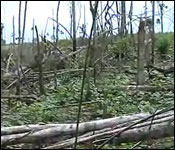
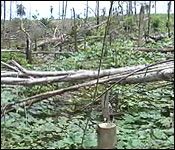
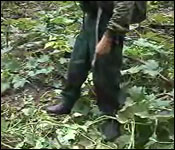 Daniel Ortiz reporting
Looking at it, a uniformed observer might think that this clearing of land is unimportant, and routine, just another developer working on his or her property. But it is not; this actually a part of the Chiquibul Forest - 55 acres to be exact in a protected reserve where farming is prohibited.
Daniel Ortiz reporting
Looking at it, a uniformed observer might think that this clearing of land is unimportant, and routine, just another developer working on his or her property. But it is not; this actually a part of the Chiquibul Forest - 55 acres to be exact in a protected reserve where farming is prohibited.
The Guatemalan milpa farmers from South Peten have been making more brazen encroachments in this protected area. More unthinkable than that is that these downed trees were not going be used for anything; nope, the farmer's intentions were to burn them completely, and then plant on the land.
We asked the Executive Director of FCD about the significance of this unauthorized milpa.
Rafael Manzanero - Executive Director, FCD
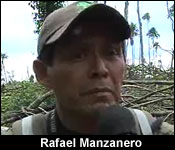 "We are approximately 2km from the Western Border in the Chiquibul National Park in Belizean territory. This is one of the typical farms that we had been reporting concerning the agricultural expansion into this protected area into the Belizean territory.
"We are approximately 2km from the Western Border in the Chiquibul National Park in Belizean territory. This is one of the typical farms that we had been reporting concerning the agricultural expansion into this protected area into the Belizean territory.
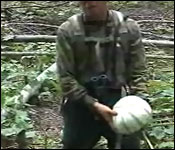
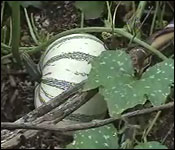 So what you can see here is basically a plantation of pumpkin. Pumpkin is usually used a lot by Guatemalans because of the seed so that is sold a lot in the local communities - so what you'll see here is that main kind of crop, although you will also find a mix of corn if you walk around this particular farm. We will estimate that this will take a week or so and because the idea is that firstly we have to cut down the big trees which is called the 'slash' and then the burn - the type of farming is called the 'slash and burn method of cultivation'. So once they burn it then they are able to plant so you will see some of the trees that have been burnt on the stems and so it will take about a week."
So what you can see here is basically a plantation of pumpkin. Pumpkin is usually used a lot by Guatemalans because of the seed so that is sold a lot in the local communities - so what you'll see here is that main kind of crop, although you will also find a mix of corn if you walk around this particular farm. We will estimate that this will take a week or so and because the idea is that firstly we have to cut down the big trees which is called the 'slash' and then the burn - the type of farming is called the 'slash and burn method of cultivation'. So once they burn it then they are able to plant so you will see some of the trees that have been burnt on the stems and so it will take about a week."
Yes, you heard right, 1 week to do 55 acres of damage to a section of the Chiquibul. It doesn't sound like much on paper, but over time it adds up when considering years of illegal incursions inside this national reserve.
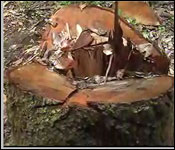
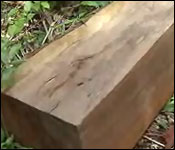
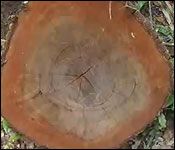 The vast amount of land that the farmers have strong-armed was no easy task. They had to cut down huge trees in the densely forest to make this clearing. Manzanero said that this tells how highly motivated the Guatemalan farmer was.
The vast amount of land that the farmers have strong-armed was no easy task. They had to cut down huge trees in the densely forest to make this clearing. Manzanero said that this tells how highly motivated the Guatemalan farmer was.
Rafael Manzanero
"It's highly motivated and highly determined individuals that you will find around these areas. We all know that these are all Guatemalans who are operating in zones. In fact we conducted an over flight along the Western Border, we documented over 43 of these Milpas which were basically removed out of its first cover and then it will eventually become a farm like this."
But this illegal clearing of the forest was not the only one we got to witness, as the Chief Range explained, there was second milpa nearby.
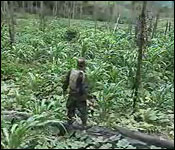 Jose Sierra - Chief Ranger, FCD
Jose Sierra - Chief Ranger, FCD
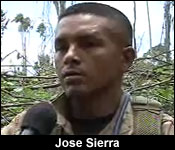 "From here we're going to move a bit north from this location - it's not going to be more than 800 meters."
"From here we're going to move a bit north from this location - it's not going to be more than 800 meters."
And so we travelled to that clearing, which was bigger than that last one, 67 acres of forest razed for a second milpa farm. If the rapier efficiency does not provoke nationalist sentiment to save the Chiquibul, the FCD thinks it should, especially because Belize is losing approximately over a million dollars annually due to these encroachments.
The experts say that this is only one aspect of the valuation, and in reality it may be multiples of that figure.
Rafael Manzanero
"It is very difficult to look at the true value of everything because once we start to look at the fragmentation of the forest, we look at the loss of wild animals, we look at the degradation of the land, and we look at the destruction of the timber and trees and everything. But to give you one example only - what we have lost annually along the border, in terms of these trees that you have seen already moved but we're not only loosing in biomass but we're losing approximately $526,000 USD only in carbon - that's only one of the values. So this thing is going into the thousands and thousands of dollars that we are losing as a country and more importantly we're losing the part of a virgin forest that belongs to Belize."
So, how do the rangers and the BDF tie a Guatemalan to the farm? They say it is not a simple matter.
Rafael Manzanero
"We have about to some individuals but they have been particularly under work that is being done around this barrier and we are able to spot them they would just run away so it's very hard to capture them."
Daniel Ortiz
"If you do capture them, how difficult is it to tie them to this particular destruction at this particular farm?"
Rafael Manzanero
"If we find them infraganti or we find them on the spot then of course it is very clear and obvious for us to convict them in terms of doing farming inside a protected area but otherwise once we find them inside of Belize of course they are here as illegal immigrants inside of the country."



